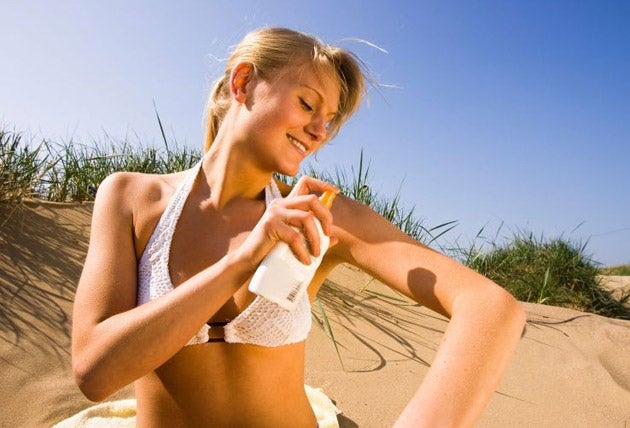Consuming Issues: Some sun creams are not worth the slather

Your support helps us to tell the story
From reproductive rights to climate change to Big Tech, The Independent is on the ground when the story is developing. Whether it's investigating the financials of Elon Musk's pro-Trump PAC or producing our latest documentary, 'The A Word', which shines a light on the American women fighting for reproductive rights, we know how important it is to parse out the facts from the messaging.
At such a critical moment in US history, we need reporters on the ground. Your donation allows us to keep sending journalists to speak to both sides of the story.
The Independent is trusted by Americans across the entire political spectrum. And unlike many other quality news outlets, we choose not to lock Americans out of our reporting and analysis with paywalls. We believe quality journalism should be available to everyone, paid for by those who can afford it.
Your support makes all the difference.Let's face it, whizzing to the airport or a British beach, sun care can be the last thing on our minds. Bottles of lotion are grabbed at the last minute in Boots, if at all.
Research suggests Britons are lazy when it comes to sun care. Perhaps it's because we live in a grey climate, but most of us have no idea how, or when, to apply the protective creams properly.
Even if we are doing it right, we may be unaware of the differences that exist between products, some of which appear to afford less protection than that stated on the label. There is also confusion about Sun Protection Factor (SPF).
All this ignorance is unfortunate because, despite the temporary lull in foreign bookings during the recession, tourists are travelling to ever further-flung, hotter destinations such as Dubai, Mexico and Kenya. And, due to climate change, our summers are also becoming warmer.
Sun-burn can be inconvenient and painful and, in extreme cases, can kill. But the real trouble can start decades later: with skin cancer.
With the national fondness for tanning salons and the rise of jet travel, skin cancer rates are soaring. Incidents of the worst form – malignant melanoma – have quadrupled since the 1970s and 2,600 people die of the disease every year. One third of sufferers are under 50.
Britain has more cases than scorching Australia (thanks to its "slip, slop, slap" campaign – "slip on a shirt, slop on sunscreen, and slap on a hat"), though scorching Oz has more serious malignant melanomas.
As a result, the Government recommends that people buy creams with a Sun protection factor of at least 15.
Despite the advice, a trawl of high street stores will reveal plenty of creams with less protection: for instance, a Nivea SPF 6, a Piz Buin SPF 6, and Soltan SPF 4 (the own-brand sold by Boots, the country's biggest chemist).
Contrary to public belief, SPF does not equate to the number of minutes you can spend in the sun without getting burnt, ie, SPF 15 means 15 minutes of protection.
It is the factor by which you extend your natural protection to UV rays. In other words, an SPF will give you 15 times your natural protection against the sun, which, confusingly, will depend on the kind of skin you have. Fair-skinned people are most susceptible and should take most interest in what they buy.
Recent surveys have indicated that, when it comes to sun creams, you get what you pay for. In its test of factor 15 creams this year, consumer group Which? found Nivea and Hawaiian Tropic had more protection than stated.
By contrast, Malibu, Tesco, Wilko and Marks & Spencer creams had less protection (though they all insisted their tests proved the creams worked).
Last year Which? also found Malibu, Tesco and Marks & Spencer creams failed to hit the advertised factory 15. Which? does acknowledge though that sun cream tests are to some degree subjective, depending on analysis of burned patches of skin.
Nonetheless – with the notable exception of Asda's Sun System creams ('best buys' both years) – the trend is that more expensive brands outperform own-brands.
How much should you put on? Cancer Research UK says you should apply cream every two hours you are out in the sun and after swimming. Sun cream appears to be most effective if applied about 20 minutes before you go out.
People often underestimate how much cream to use. In a test last year, Which? asked four bathers at London Fields lido to apply lotion.
Compared with the correct amount of cream they should have slapped on to stop them burning, the swimmers applied 10 per cent, 25 per cent, 30 per cent and 50 per cent of the correct amount. One said: "I don't really know how much to put on." Another – the one who put on only one-tenth – said: "To be honest, I'm a bit slack with it." Another said she often got burnt.
Following a few simple rules can help avoid that. Limit exposure to the sun between 11am and 3pm. And buy branded sun lotions with an SPF 15 and above and apply them regularly throughout the day.
Heroes & Villians
Hero
Inventor of vacuum cleaners, Sir James Dyso has once again proved that consumer gadgets can be practical and attractive with the launch of his new handheld DC31 machine. Though, at £130 a time, it is quite expensive.
Villains
Easyjet, Monarch, Jet2 and AirBerlin are adding up to £10 to the cost of a flight and flouting EU laws by automatically adding travel insurance during the booking process, according to Which? Holiday. The EU says airlines cannot automatically add extras such as insurance at the time of booking.
m.hickman@independent.co.uk
Join our commenting forum
Join thought-provoking conversations, follow other Independent readers and see their replies
Comments